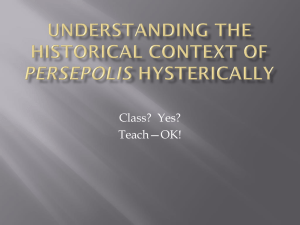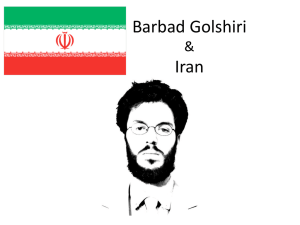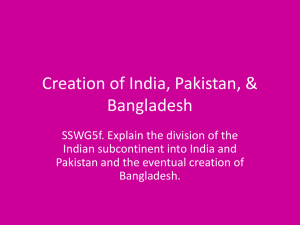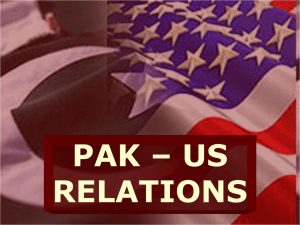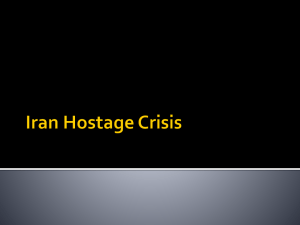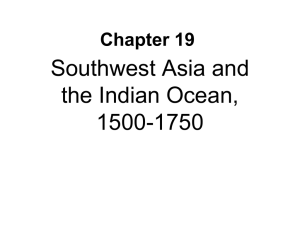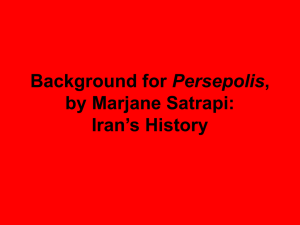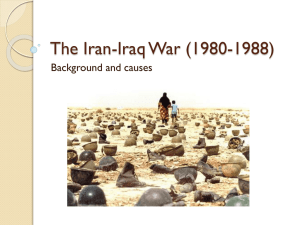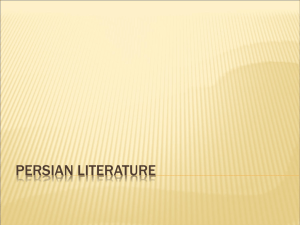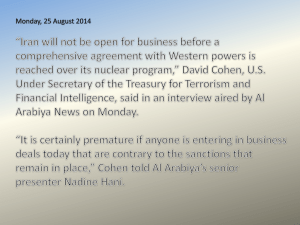AP World History: Decolonization
advertisement
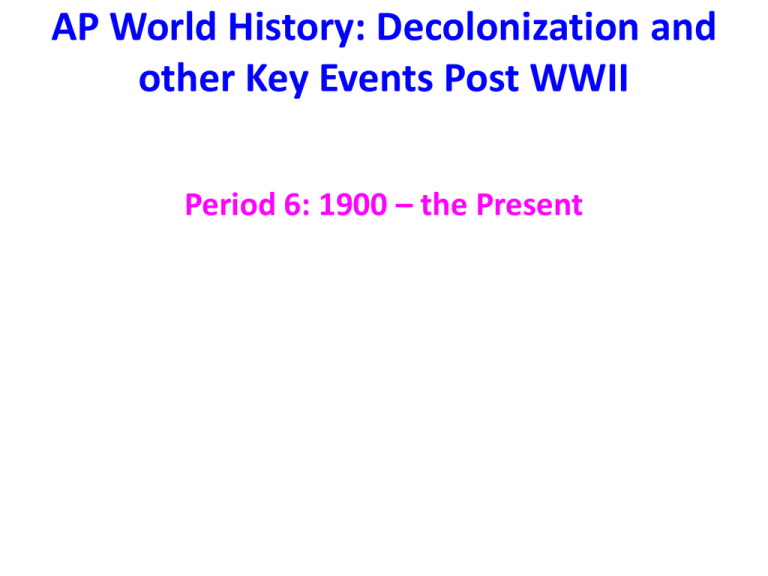
AP World History: Decolonization and other Key Events Post WWII Period 6: 1900 – the Present The Road to Independence A) The Atlantic Charter was drafted by U.S. President Franklin Roosevelt (left) and British Prime Minister Winston Churchill (right) in 1941. In it they voiced support for "the right of all peoples to choose the form of government under which they will live.” B) The costs of WWII led to war debts and the need to rebuild Western Europe, leaving less money for maintaining overseas colonies. Independence in South Asia “The Indian independence movement first gained momentum at the beginning of the 20th century, and after WWI Gandhi organized the first of many effective passiveresistance campaigns in protest of Britain's oppressive rule in India. In the 1930s, the British government made some concessions to the Indian nationalists, but during WWII discontent with British rule had grown to such a degree that Britain feared losing India to the Axis. Gandhi rejected the British promises of Indian self-government after the war and organized the nonviolent "Quit India" campaign to hasten the British departure. British colonial authorities responded by jailing Gandhi and hundreds of others. Anti-British demonstrations accelerated after the war, and in 1947 the Indian National Congress reluctantly accepted the creation of Pakistan to appease the Muslim League and conclude the independence negotiations. On August 15, 1947, the Indian Independence Bill took effect, inaugurating a period of religious turmoil in India and Pakistan that would result in the deaths of hundreds of thousands, including Gandhi, who was assassinated by a Hindu fanatic in January 1948 during a prayer vigil to an area of Muslim-Hindu violence.” www.history.com Independence in South Asia Continued… Pakistan was composed of two noncontiguous regions, East Pakistan and West Pakistan, separated by Indian territory. The state of Kashmir, which had a predominantly Muslim population but a Hindu leader, shared borders with both India and West Pakistan. The argument over which nation would incorporate the state led to the first India-Pakistan War in 1947–48 and ended with UN mediation. Kashmir joined the Republic of India, but the Pakistani Government continued to believe that the majority Muslim state rightfully belonged to Pakistan. Conflict resumed again in early 1965, when Pakistani and Indian forces clashed over the disputed territory. Hostilities intensified that August when the Pakistani army attempted to take Kashmir by force, though unsuccessfully. This time, the international politics of the Cold War affected the nature of the conflict. The US had a history of ambivalent relations with India. During the 1950s, the US hoped to maintain a regional balance of power, which meant not allowing India to influence the political development of other states. However, a 1962 border conflict between India and China ended with a decisive Chinese victory, which motivated the US and the UK to provide military supplies to the Indian army. After the clash with China, India also turned to the USSR for assistance, which placed some strains on U.S.-Indian relations. However, the US also provided India with considerable development assistance throughout the 1960s and 1970s. U.S.-Pakistani relations had been more consistently positive. The U.S. looked to Pakistan for assistance in holding the line against communist expansion by joining the Southeast Asia Treaty Organization (SEATO) in 1954... Pakistan’s interest in SEATO stemmed from its desire to develop its military and defensive capabilities, which were substantially weaker than those of India. Both the US and the UK supplied arms to Pakistan in these years. After Pakistani troops invaded Kashmir, India asked the UN to end the current conflict. The Security Council passed Resolution 211 on September 20 calling for an end to the fighting and negotiations on the settlement of the Kashmir problem, and the US and the UK supported the UN decision by cutting off arms supplies to both belligerents. Pakistan felt the effects more keenly since it had a much weaker military in caparison to India. The UN resolution and the halting of arms sales had an immediate impact. India accepted the ceasefire on September 21 and Pakistan on September 22. The ceasefire alone did not resolve the status of Kashmir, and both sides accepted the USSR as a third-party mediator. Negotiations in Tashkent concluded in January 1966, with both sides giving up territorial claims, withdrawing their armies from the disputed territory. Nevertheless, although the Tashkent agreement achieved its short-term aims, conflict in South Asia would reignite a few years later.” http://history.state.gov/milestones/1961-1968/india-pakistan-war Independence in South Asia Continued… “Inequalities between. East and West Pakistan soon stirred up a sense of Bengali nationalism that had not been reckoned with during the push for Muslim independence. When the Pakistan government declared that `Urdu and only Urdu' would be the national language, the Bangla-speaking Bengalis decided it was time to assert their cultural identity and a push for self-government. When the Awami League, a nationalistic party, won a majority in the 1971 national elections, the president of Pakistan, faced with this unacceptable result, postponed opening the National Assembly. Riots and strikes broke out in East Pakistan, the independent state of Bangladesh was unilaterally announced, and Pakistan sent troops to quell the rebellion. The ensuing war was one of the shortest and bloodiest of modern times, with the Pakistan army occupying all major towns, using napalm against villages, and slaughtering and raping villagers. Bangladeshis refer to Pakistan's brutal tactics as attempted genocide. Border clashes between Pakistan and India increased as Indiantrained Bangladeshi guerrillas crossed the border. When the Pakistani air force made a pre-emptive attack on Indian forces, open warfare ensued. Indian troops crossed the border and the Pakistani army found itself being attacked from the east by the Indian army, the north and east by guerrillas and from all quarters by the civilian population. In 11 days it was all over and Bangladesh, the world's 139th country, officially came into existence. Sheikh Mujib, one of the founders of the Awami League, became the country's first prime minister in January 1972.” http://www.bangla2000.com/bangladesh/history.shtm Bangladesh Today A rally in Dhaka, the capital of Bangladesh 2013 Bangladeshi Village Women, 2008 Japan Post WWII “In Sept 1945, General Douglas MacArthur took charge of the Supreme Command of Allied Powers (SCAP) and began the work of rebuilding Japan. Although Great Britain, the Soviet Union, and the Republic of China had an advisory role as part of an “Allied Council,” MacArthur had the final authority. The Allies punished Japan for its past militarism and expansion by convening war crimes trials in Tokyo. At the same time, SCAP dismantled the Japanese army and banned former military officers from taking roles of political leadership in the new government. In the economic field, SCAP introduced land reform, designed to benefit the majority tenant farmers and reduce the power of rich landowners. MacArthur also tried to break up the large Japanese business conglomerates as part of the effort to transform the economy into a free market capitalist system. In 1947, Allied advisors dictated a new constitution to Japan’s leaders [which included] downgrading the emperor’s status to that of a figurehead without political control and placing more power in the parliamentary system, promoting greater rights and privileges for women, and renouncing the right to wage war, which involved eliminating all non-defensive armed forces. SCAP became concerned that a weak Japanese economy would increase the influence of [communism]. The final agreement allowed the United States to maintain its bases in Okinawa and elsewhere in Japan, and the U.S. Government promised Japan a bilateral security pact…” http://history.state.gov/milestones/1945-1952/japan-reconstruction General Douglas MacArthur Fred Korematsu In 1942, FDR signed an executive order forcing many Japanese Americans into internment camps, including Fred Korematsu. Korematsu challenged his conviction in the courts saying that Congress, the President, and the military authorities did not have the power to issue the relocation orders and that he was being discriminated against based on his race. The case went to the Supreme Court, which said that the need to protect the country was a greater priority than the individual rights of the Japanese and Japanese Americans. "As long as my record stands in federal court, any American citizen can be held in prison or concentration camps without trial or hearing. I would like to see the government admit they were wrong and do something about it, so this will never happen again to any American citizen of any race, creed, or color." —Fred Korematsu 1983 The Nuremberg Trials “Held for the purpose of bringing Nazi war criminals to justice, the Nuremberg trials were a series of 13 trials carried out in Nuremberg, Germany, between 1945 and 1949. The defendants, who included Nazi Party officials and high-ranking military officers along with German industrialists, lawyers and doctors, were indicted on such charges as crimes against peace and crimes against humanity. Nazi leader Adolf Hitler committed suicide and was never brought to trial... In Dec 1942, the Allied leaders of Great Britain, the US and the USSR ‘issued the first joint declaration officially noting the mass murder of European Jewry and resolving to prosecute those responsible for violence against civilian populations,’ according to the US Holocaust Memorial Museum… The Allies established the laws and procedures for the Nuremberg trials with the London Charter of the International Military Tribunal, issued on Aug 8, 1945. The charter defined three categories of crimes: crimes against peace (including planning, preparing, starting or waging wars of aggression or wars in violation of international agreements), war crimes (including violations of customs or laws of war, including improper treatment of civilians and prisoners of war) and crimes against humanity (including murder, enslavement or deportation of civilians or persecution on political, religious or racial grounds). It was determined that civilian officials as well as military officers could be accused of war crimes. The best-known of the Nuremberg trials was the Trial of Major War Criminals, held from Nov 20, 1945, to Oct 1, 1946… The Nuremberg Trials Continued… Twenty-four individuals were indicted, along with six Nazi organizations determined to be criminal (such as the “Gestapo,” or secret state police). Hitler and two of his top associates, Heinrich Himmler and Joseph Goebbels had each committed suicide in the spring of 1945 before they could be brought to trial. the international tribunal found all but three of the defendants guilty. Twelve were sentenced to death, one in absentia, and the rest were given prison sentences ranging from 10 years to life behind bars. Ten of the condemned were executed by hanging on October 16, 1946. Hermann Göring (1893-1946), Hitler’s designated successor and head of the “Luftwaffe” (German air force), committed suicide the night before his execution. Following the Trial of Major War Criminals, there were 12 additional trials held at Nuremberg from Dec 1946 to April 1949. The findings at Nuremberg led directly to the United Nations Genocide Convention (1948) and Universal Declaration of Human Rights (1948), as well as the Geneva Convention on the Laws and Customs of War (1949). In addition, the International Military Tribunal supplied a useful precedent for the trials of Japanese war criminals in Tokyo (1946-48); the 1961 trial of Nazi leader Adolf Eichmann (1906-62); and the establishment of tribunals for war crimes committed in the former Yugoslavia (1993) and in Rwanda (1994).…” www.history.com Defendants at the Nuremberg Trials But Not All Nazis Were Put on Trial... “A secret history of the United States government’s Nazi-hunting operation concludes that American intelligence officials created a “safe haven” in the US for Nazis and their collaborators after WWII… The 600-page report, which the Justice Department has tried to keep secret for four years, provides new evidence about more than two dozen of the most notorious Nazi cases of the last three decades… The Justice Department report, describing what it calls “the government’s collaboration with persecutors,” says that O.S.I investigators learned that some of the Nazis “were indeed knowingly granted entry” to the United States, even though government officials were aware of their pasts. “America, which prided itself on being a safe haven for the persecuted, became — in some small measure — a safe haven for persecutors as well,” it said.” By ERIC LICHTBLAU Published: November 13, 2010 The NY Times “The CIA organized Cold War spy networks that included former Nazis and failed to act on a 1958 report that fugitive Nazi war criminal Adolf Eichmann was living in Argentina, newly released CIA records show. The records were among 27,000 pages of documents made public yesterday at the National Archives. They shed new light on the secret protection and support given to former Nazi officials and Nazi collaborators by U.S. intelligence agencies as fighting communism became the central aim of American foreign policy in the years after WWII. "It was not U.S. policy to track Nazi war criminals once the Cold War began," said historian Timothy Naftali of the University of Virginia, a Cold War expert who has studied the new documents. "The CIA based its decisions about using former SS men or unreconstructed Nazis solely on operational considerations.” By Christopher Lee Washington Post June 7, 2006 The Road to African Independence Recall the Pan African Movement was a movement of the early 20th century to forge cultural unity of blacks around the world, to gain equal rights, education, and independence for Africa from imperialist nations. One of its main leaders was W.E.B. DuBois. The Negritude Movement was born out of the Pan African Movement. “Négritude is a cultural movement launched in 1930s Paris by Frenchspeaking black students from France's colonies in Africa and the Caribbean territories. These black intellectuals converged around issues of race identity and black internationalist initiatives to combat French imperialism. They found solidarity in their common ideal of affirming pride in their shared black identity and African heritage, and reclaiming African self-determination, self–reliance, and self–respect…” Bertrade Ngo-Ngijol Banoum –Lehman College Kwame Nkrumah gained independence for Ghana in 1957, leading the way for other African nations to follow. Ghana, Africa “A State in the grip of neocolonialism is not master of its own destiny. It is this factor which makes neo-colonialism such a serious threat to world peace.” Kwame Nkrumah Celebration of Ghana’s 57th Year of Independence, 2014! South Africa’s Road to Independence In 1948, the National Party (NP) won the all-white elections and began passing legislation an even stricter policy than previously of white domination and racial separation known as "apartheid" (separateness). In the early 1960s, following a protest in Sharpeville in which 69 protesters were killed by police and 180 injured, Nelson Mandela and many other antiapartheid leaders were convicted and imprisoned on charges of treason. In May 1961, South Africa abandoned its British dominion status and declared itself a republic. In 1984, a new constitution came into effect in which whites allowed coloreds and Asians a limited role in the national government and control over their own affairs in certain areas. Ultimately, however, all power remained in white hands. Popular uprisings in black and colored townships in 1976 and 1985 helped to convince some of the need for change. Secret discussions between those members and Nelson Mandela began in 1986. In Feb 1990, President F.W. de Klerk, announced the unbanning of the anti-apartheid groups. Two weeks later, Nelson Mandela was released from prison. In 1991, the Group Areas Act, Land Acts, and the Population Registration Act--the last of the socalled "pillars of apartheid"--were abolished. A long series of negotiations ensued, resulting in a new constitution promulgated into law in December 1993. The country's first nonracial elections were held on April 26-28, 1994, resulting in the installation of Nelson Mandela as President on May 10, 1994. Nelson Mandela stepped down as President of the ANC at the party's national conference in December 1997. http://globaledge.msu.edu/countries/south-africa/history South Africa Continued… Nelson Mandela The Green Revolution: Did it Help or Hurt Africa? “Most industrial countries achieved sustained food surpluses by the second half of the 20th century. These advances were much slower in reaching developing countries. The colonial powers invested little in the food production systems of these countries… By the mid-1960s, hunger and malnutrition were widespread, especially in Asia, which increasingly depended on food aid from rich countries…. In response, the Rockefeller and Ford foundations took the lead in establishing an international agricultural research system to help transfer and adapt scientific advances to the conditions in developing countries. The first investments were in research on rice and wheat, two of the most important food crops for developing countries. The breeding of improved varieties, combined with the expanded use of fertilizers, other chemical inputs, and irrigation, led to dramatic yield increases in Asia and Latin America, beginning in the late 1960s. In 1968, this movement became known as the “Green Revolution”... Although the term Green Revolution originally described developments for rice and wheat, high-yielding varieties (HYVs) have since been developed for other major food crops important to developing countries, including sorghum, millet, maize, cassava, and beans. he adoption of HYVs occurred quickly. By 1970, about 20 percent of the wheat area and 30 percent of the rice area in developing countries were planted to HYVs, and by 1990, the share had increased to about 70 percent for both crops. Yields of rice and wheat virtually doubled. Higher yields and profitability also led farmers to increase the area of rice and wheat they grew at the expense of other crops. And with fastergrowing varieties and irrigation, they grew more crops on their land each year. These changes more than doubled cereal production in Asia between 1970 and 1995, while population increased by 60 percent. Instead of widespread famine, cereal and calorie availability per person increased by nearly 30 percent, and wheat and rice became cheaper. Latin America experienced significant gains as well, but the impact in SubSaharan Africa was much more modest. Poor infrastructure, high transport costs, limited investment in irrigation, and pricing and marketing policies that penalized farmers made the Green Revolution technologies too expensive or inappropriate for much of Africa.” http://www.ifpri.org/sites/default/files/pubs/pubs/ib/ib11.pdf Silent Spring: Did it Help or Hurt Developing Nations? Rachel Carson, a scientist, wrote Silent Spring (1962) in which she warned against the use of pesticides such as DDT and other chlorinated hydrocarbons. Carson “meticulously described how DDT entered the food chain and accumulated in the fatty tissues of animals, including human beings, and caused cancer and genetic damage. A single application on a crop, she wrote, killed insects for weeks and months, and not only the targeted insects but countless more, and remained toxic in the environment even after it was diluted by rainwater. Carson concluded that DDT and other pesticides had irrevocably harmed birds and animals and had contaminated the entire world food supply. The book's most haunting and famous chapter, "A Fable for Tomorrow," depicted a nameless American town where all life -- from fish to birds to apple blossoms to human children -had been "silenced" by the insidious effects of DDT.” http://www.nrdc.org/health/pesticides/hcarson.a sp “A Maryland Congressman is quoted as saying that malaria deaths might have been prevented had DDT not been banned. That happens to be true. DDT kills mosquitoes, which carry malaria, which was all but eradicated before DDT was banned… The Washington Post concedes that "numerous" deaths might have been prevented by DDT… According to these CDC figures, malaria kills more than 800,000 children under age five every year. Every year, 800,000 small children die from malaria, a disease once nearly eradicated. Ponder that.” http://www.forbes.com/sites/henrymiller/201 2/09/05/rachel-carsons-deadly-fantasies/ The World Wildlife Fund: Did It Help or Hurt Africa? “The world’s leading conservation organization, WWF works in 100 countries and is supported by 1.2 million members in the United States and close to 5 million globally. WWF’s unique way of working combines global reach with a foundation in science, involves action at every level from local to global, and ensures the delivery of innovative solutions that meet the needs of both people and nature.” www.worldwildlife.org “In Nov. 2011, Prince Charles, who serves as president of WWF UK, visited Tanzania to present five local leaders with “Living Planet” awards for their work. According to an article in the London newspaper The Telegraph, ‘Shortly before the prince’s arrival, it was revealed that thousands of villagers had been evicted from the forest, their huts in the paddy fields torched and their coconut palms felled. This was carried out by the Tanzanian government’s Forestry and Beekeeping Division, with which the WWF has been working.’” By Drew Johnson 2012 "If I were reincarnated I would wish to be returned to earth as a killer virus to lower human population levels" - Prince Philip Duke of Edinburgh, leader of the World Wildlife Fund, quoted in "Are You Ready for Our New Age Future?" Insiders Report, American Policy Center, December 1995. 1979 Iranian Revolution In 1941, British and Soviet troops occupied Iran, and the first Pahlavi shah, who they regarded with suspicion, was forced to abdicate in favor of his son, Mohammad Reza. However, in the early 1950s, the shah was eclipsed by Mohammad Mosaddeq, a zealous Iranian nationalist who convinced the Parliament to nationalize Britain's extensive oil interests in Iran. Mohammad Reza, who maintained close relations with Britain and the United States, opposed the decision. In August 1953, Mohammad Reza attempted to dismiss Mosaddeq, but the premier's popular support was so great that the shah himself was forced out of Iran. A few days later, British and U.S. intelligence agents orchestrated a stunning coup d'etat against Mosaddeq, and the shah returned to take power as the sole leader of Iran and became a close Cold War ally of the United States in the Middle East. In 1963, the shah launched his "White Revolution," that included land reform, infrastructure development, voting rights for women, and the reduction of illiteracy. Although these programs were applauded by many in Iran, Islamic leaders were critical of what they saw as the westernization of Iran. Ruhollah Khomeini, a Shiite cleric, was particularly vocal in his criticism and called for the overthrow of the shah and the establishment of an Islamic state. In 1964, Khomeini was exiled and settled across the border in Iraq, where he sent radio messages to incite his supporters. The shah saw himself foremost as a Persian king and in 1971 held an extravagant celebration of the 2,500th anniversary of the pre-Islamic Persian monarchy. Religious discontent grew, and the shah became more repressive, using his brutal secret police force to suppress opposition. This alienated students and intellectuals in Iran, and support for Khomeini grew. Discontent was also rampant in the poor and middle classes, who felt that the economic developments of the White Revolution had only benefited the ruling elite. In 1978, anti-shah demonstrations broke out in Iran's major cities. On Sept 8, 1978, the shah's security force fired on a large group of demonstrators, killing hundreds and wounding thousands. Khomeini called for the shah's immediate overthrow, and on Dec 11 a group of soldiers mutinied and attacked the shah's security officers. With that, his regime collapsed and the shah fled. The shah traveled to several countries before entering the United States in October 1979 for medical treatment of his cancer. In Tehran, Islamic militants responded on November 4 by storming the U.S. embassy and taking the staff hostage. With the approval of Khomeini, the militants demanded the return of the shah to Iran to stand trial for his crimes. The United States refused to negotiate, and 52 American hostages were held for 444 days. Mohammad Reza Shah Pahlavi died in Egypt in July 1980. Imam Ruhollah Musavi Khomeini Mohammad Reza Pahlavi Iranian Hostage Crisis “On Nov 4, 1979, a group of Iranian students stormed the U.S. Embassy in Tehran, taking more than 60 American hostages. The immediate cause of this action was President Jimmy Carter’s decision to allow Iran’s deposed Shah, a pro-Western autocrat, to come to the US for cancer treatment… it was also a dramatic way for the student revolutionaries to declare a break with Iran’s past and an end to American interference in its affairs, and to raise the profile of the revolution’s leader, the antiAmerican cleric Ayatollah Ruhollah Khomeini. The students set their hostages free on January 21, 1981, 444 days after the crisis began and just hours after President Ronald Reagan delivered his inaugural address. Many historians believe that hostage crisis cost Jimmy Carter a second term as president.” www.history.com Iran Iraq War 1980 - 1988 Open warfare began on Sept. 22, 1980, when Iraqi armed forces invaded western Iran along the countries’ joint border, though Iraq claimed that the war had begun earlier that month, on September 4, when Iran shelled a number of border posts. Fighting was ended by a 1988 cease-fire, though the resumption of normal diplomatic relations and the withdrawal of troops did not take place until the signing of a formal peace agreement on Aug. 16, 1990. The roots of the war lay in a number of territorial and political disputes between Iraq and Iran. Iraq wanted to seize control of the rich oilproducing Iranian border region of Khūzestān, a territory inhabited largely by ethnic Arabs over which Iraq sought to extend some form of suzerainty. Iraqi president Ṣaddām Ḥussein wanted to reassert his country’s sovereignty over both banks of the Shaṭṭ al-ʿArab, a river formed by the confluence of the Tigris and Euphrates rivers that was historically the border between the two countries. Ṣaddām was also concerned over attempts by Iran’s Islamic revolutionary government to incite rebellion among Iraq’s Shīʿite majority. The end came on July 18, when Iran accepted UN Resolution 598 calling for an immediate cease-fire, though minor Iraqi attacks continued for a few more days after the truce came into effect on July 20, 1988. http://www.britannica.com/EBchecked/topic/293527/Iran-Iraq-War The Iran – Contra Affair 1986 - 1987 “The Iran-contra affair consisted of 3 interconnected parts: The Reagan administration sold arms to Iran, a country desperate for materiel during its lengthy war with Iraq; in exchange for the arms, Iran was to use its influence to help gain the release of Americans held hostage in Lebanon; and the arms were purchased at high prices, with the excess profits diverted to fund the Reagan-favored "contras" fighting the Sandinista government in Nicaragua. It was a grand scheme that violated American law and policy all around: Arms sales to Iran were prohibited; the U.S. government had long forbidden ransom of any sort for hostages; and it was illegal to fund the contras above the limits set by Congress. The first press revelations occurred in November 1986, and were followed by three investigations, conducted by a presidentially appointed commission headed by former Texas U.S. senator John Tower, by Congress (in televised hearings in mid-1987) and finally by a special federal prosecutor. Charges brought by the prosecutor eventually resulted in the convictions of several members of the Reagan administration, including Reagan's national security adviser, Adm. John Poindexter, and his deputy, Lt. Col. Oliver North. (North's multi-count conviction was set aside on appeal.) Reagan himself was never charged with any offense, although opinions differed about his knowledge of, and culpability for, the affair.” http://www.washingtonpost.com/wpsrv/politics/special/clinton/frenzy/iran.htm China under Mao Mao Zedong and his communist supporters had been fighting against what they claimed was a corrupt and decadent Nationalist government in China since the 1920s. Despite massive U.S. support for the Nationalist regime, Mao's forces were victorious in 1949 and drove the Nationalist government onto the island of Taiwan. On October 1, 1949, the People's Republic of China was formally announced, with Mao Zedong as its leader. He would remain in charge of the nation until his death in 1976. The Great Leap Forward was a push by Mao Zedong to change China from a predominantly agrarian (farming) society to a modern, industrial society in just five years. Between 1958 and 1960, millions of Chinese citizens were moved onto communes. Some were sent to farming cooperatives, while others worked in small manufacturing. All work was shared on the communes; from childcare to cooking, daily tasks were collectivized. The Great Leap Forward was supposed to be a 5-year plan, but it was called off after just three tragic years. The period between 1958 and 1960 is known as the "Three Bitter Years" in China. Mao’s Great Leap Forward “The worst catastrophe in China’s history, and one of the worst anywhere, was the Great Famine of 1958 to 1962, and to this day the ruling Communist Party has not fully acknowledged the degree to which it was a direct result of the forcible herding of villagers into communes under the “Great Leap Forward” that Mao Zedong launched in 1958. In all, the records I studied suggest that the Great Leap Forward was responsible for at least 45 million deaths. Between 2 and 3 million of these victims were tortured to death or summarily executed, often for the slightest infraction. People accused of not working hard enough were hung and beaten; sometimes they were bound and thrown into ponds. Punishments for the least violations included mutilation and forcing people to eat excrement. One report dated Nov. 30, 1960, and circulated to the top leadership — most likely including Mao — tells how a man named Wang Ziyou had one of his ears chopped off, his legs tied up with iron wire and a 10-kilogram stone dropped on his back before he was branded with a sizzling tool. His crime: digging up a potato...” By FRANK DIKÖTTER Published: December 15, 2010 NY Times Focus Questions 1. What events allowed for decolonization? Was decolonization always positive? Why or why not? How did it differ in Africa, SW Asia, and India? 2. How did Rachel Carson’s Silent Spring and the Green Revolution affect developing nations? Was it for the better or the worse? 3. Was Mao’s Great Leap Forward the same as Stalin’s 5 Year Plan? 4. Should the US have gotten involved in Iran? Why or why not?
